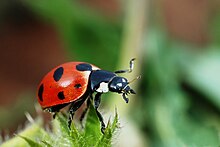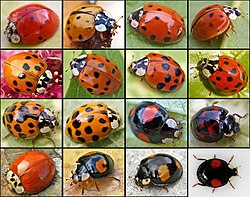
Back Lieweheersbesie Afrikaans Coccinellidae AN دعسوقيات Arabic ليدى باج ARZ Coccinellidae AST Patak mantcoc ATJ Parabüzənlər Azerbaijani Ҡамҡалар Bashkir Potpalakė BAT-SMG Божыя кароўкі Byelorussian
| Lady beetle Temporal range:
| |
|---|---|

| |
| Coccinella magnifica | |
| Scientific classification | |
| Kingdom: | |
| Phylum: | |
| Class: | |
| Order: | |
| Suborder: | |
| Superfamily: | |
| Family: | Coccinellidae |
| Subfamilies [1] | |
| |


- For the sports comedy movie, see Ladybugs
Lady beetles are the Coccinellidae, a family of beetles. All species are protected by noxious fluids based on cyanide, and most have warning colouration, such as red with black spots or black stripes.
They are often called ladybugs or ladybirds, but biologists prefer the term 'coccinellid' or 'lady beetle'.
Coccinellids are found worldwide, with over 5,000 species.[3] Most species are insectivorous, feeding mainly on the true bugs, the Hemiptera. These are insects which feed on plants, such as aphids (greenfly) or scale insects. Ladybeetle larvae are also voracious (greedy) eaters of greenfly.
Harmonia axyridis (or harlequin ladybug) was introduced into North America from Asia in 1988 to control aphids. It is now the most common species there, out-competing many of the native species.[4] It has since spread to much of western Europe, reaching the UK in 2004.[4][5]
- ↑ 1.0 1.1 "Coccinellidae Latreille, 1807". Integrated Taxonomic Information System. Retrieved 24 July 2012.
- ↑ "Wikispecies: Microweiseinae". 2012. Retrieved 9 March 2013.
- ↑ Judy Allen & Tudor Humphries 2000. Are you a ladybug?, Kingfisher, p30.
- ↑ 4.0 4.1 Anon (5 October 2004). "'Deadly ladybird' sighted in UK". BBC News. BBC. Retrieved 17 June 2010.
- ↑ Anon. "The Harlequin Ladybird has landed!". The harlequin ladybird survey. Retrieved 17 June 2010.